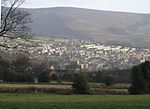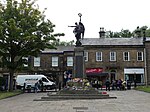The Crown Inn, Glossop
East Midlands building and structure stubsGlossopNational Inventory PubsPub stubsPubs in Derbyshire ... and 1 more
Use British English from August 2014

The Crown Inn is a public house at 142 Victoria Street, Glossop, Derbyshire SK13 8JF. It is on the Campaign for Real Ale's National Inventory of Historic Pub Interiors.It was built in the 1840s.
Excerpt from the Wikipedia article The Crown Inn, Glossop (License: CC BY-SA 3.0, Authors, Images).The Crown Inn, Glossop
James Street, High Peak Whitfield
Geographical coordinates (GPS) Address Nearby Places Show on map
Geographical coordinates (GPS)
| Latitude | Longitude |
|---|---|
| N 53.439256 ° | E -1.952422 ° |
Address
James Street
James Street
SK13 8JJ High Peak, Whitfield
England, United Kingdom
Open on Google Maps









